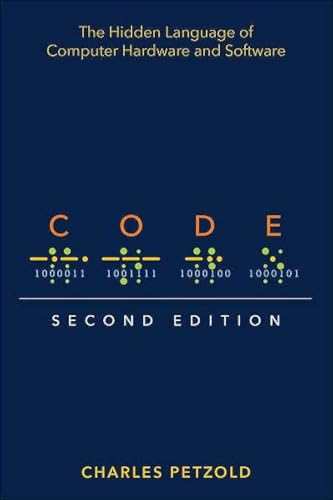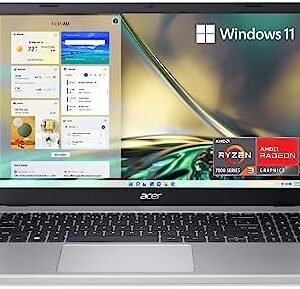Code: The Hidden Language of Computer Hardware and Software
$29.91 $39.99
Price: $39.99 - $29.91
(as of Jul 09, 2024 16:57:57 UTC – Details)
The classic guide to how computers work, updated with new chapters and interactive graphics
“For me, Code was a revelation. It was the first book about programming that spoke to me. It started with a story, and it built up, layer by layer, analogy by analogy, until I understood not just the Code, but the System. Code is a book that is as much about Systems Thinking and abstractions as it is about code and programming. Code teaches us how many unseen layers there are between the computer systems that we as users look at every day and the magical silicon rocks that we infused with lightning and taught to think.”
– Scott Hanselman, Partner Program Director, Microsoft, and host of Hanselminutes
Computers are everywhere, most obviously in our laptops and smartphones, but also our cars, televisions, microwave ovens, alarm clocks, robot vacuum cleaners, and other smart appliances. Have you ever wondered what goes on inside these devices to make our lives easier but occasionally more infuriating?
For more than 20 years, readers have delighted in Charles Petzold’s illuminating story of the secret inner life of computers, and now he has revised it for this new age of computing. Cleverly illustrated and easy to understand, this is the book that cracks the mystery. You’ll discover what flashlights, black cats, seesaws, and the ride of Paul Revere can teach you about computing, and how human ingenuity and our compulsion to communicate have shaped every electronic device we use.
This new expanded edition explores more deeply the bit-by-bit and gate-by-gate construction of the heart of every smart device, the central processing unit that combines the simplest of basic operations to perform the most complex of feats. Petzold’s companion website, CodeHiddenLanguage.com, uses animated graphics of key circuits in the book to make computers even easier to comprehend.
In addition to substantially revised and updated content, new chapters include:
Chapter 18: Let’s Build a Clock!Chapter 21: The Arithmetic Logic UnitChapter 22: Registers and BussesChapter 23: CPU Control SignalsChapter 24: Jumps, Loops, and CallsChapter 28: The World Brain
From the simple ticking of clocks to the worldwide hum of the internet, Code reveals the essence of the digital revolution.
From the Publisher


The classic guide to how computers work
This new expanded edition explores more deeply the bit-by-bit, gate-by-gate construction of the heart of every smart device—the central processing unit that combines the simplest of basic operations to perform the most complex of feats. Petzold’s companion website uses animated graphics of key circuits in the book to make computers even easier to comprehend.
In addition to substantially revised and updated content, new chapters include:
Chapter 18: Let’s Build a Clock!Chapter 21: The Arithmetic Logic UnitChapter 22: Registers and BussesChapter 23: CPU Control SignalsChapter 24: Jumps, Loops, and CallsChapter 28: The World Brain


“…the first book about programming that spoke to me.”
For me, Code was a revelation. It was the first book about programming that spoke to me. It started with a story, and it built up, layer by layer, analogy by analogy, until I understood not just the Code, but the System. Code is a book that is as much about Systems Thinking and abstractions as it is about code and programming.
Code teaches us how many unseen layers there are between the computer systems that we as users look at every day and the magical silicon rocks that we infused with lightning and taught to think.
Scott Hanselman, Partner Program Director, Microsoft, and host of Hanselminutes
Preface to the Second Edition
The first edition of this book was published in September 1999. With much delight I realized that I had finally written a book that would never need revising! This was in stark contrast to my first book, which was about programming applications for Microsoft Windows. That one had already gone through five editions in just ten years. My second book on the OS/2 Presentation Manager (the what?) became obsolete much more quickly. But Code, I was certain, would last forever.
My original idea with Code was to start with very simple concepts but slowly build to a very deep understanding of the workings of digital computers. Through this steady progression up the hill of knowledge, I would employ a minimum of metaphors, analogies, and silly illustrations, and instead use the language and symbols of the actual engineers who design and build computers. I also had a very clever trick up my sleeve: I would use ancient technologies to demonstrate universal principles under the assumption that these ancient technologies were already quite old and would never get older. It was as if I were writing a book about the internal combustion engine but based on the Ford Model T.
I still think that my approach was sound, but I was wrong in some of the details. As the years went by, the book started to show its age. Some of the cultural references became stale. Phones and fingers supplemented keyboards and mice. The internet certainly existed in 1999, but it was nothing like what it eventually became. Unicode—the text encoding that allows a uniform representation of all the world’s languages as well as emojis—got less than a page in the first edition. And JavaScript, the programming language that has become pervasive on the web, wasn’t mentioned at all.
Those problems would probably have been easy to fix, but there existed another aspect of the first edition that continued to bother me. I wanted to show the workings of an actual CPU—the central processing unit that forms the brain, heart, and soul of a computer—but the first edition didn’t quite make it. I felt that I had gotten close to this crucial breakthrough but then I had given up. Readers didn’t seem to complain, but to me it was a glaring flaw.
That deficiency has been corrected in this second edition. That’s why it’s some 70 pages longer. Yes, it’s a longer journey, but if you come along with me through the pages of this second edition, we shall dive much deeper into the internals of the CPU. Whether this will be a more pleasurable experience for you or not, I do not know. If you feel like you’re going to drown, please come up for air. But if you make it through Chapter 24, you should feel quite proud, and you’ll be pleased to know that the remainder of the book is a breeze.
Charles Petzold
Publisher : Microsoft Press; 2nd edition (August 7, 2022)
Language : English
Paperback : 480 pages
ISBN-10 : 0137909101
ISBN-13 : 978-0137909100
Item Weight : 1.52 pounds
Dimensions : 6 x 0.97 x 9.05 inches






There are no reviews yet.